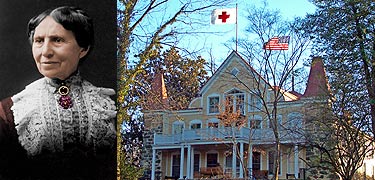Clara Barton House Tour
 \
\
1/2/10
- notes based on an outstanding tour given by Park Ranger Kevin Patti
Clara Barton was born on Christmas Day, 1881. She was raised in N. Oxford, 50 miles from Boston; she had been raised a Universalist Unitarian. Her father passed down a tradition of service; he had been a captain in the Army and founded a local Universalist church in Oxford, Massachusetts.
She was the youngest of 5 children, with a gap of 10 years from the next youngest. They taught her and she became a school teacher in Massachusetts at age 17.
At age 30, she wanted to do something more, so she decided to pursue a university education, something hard for women in those days. She went to Clinton Liberal Institute in Clinton, NY, run by Universalists.
She then moved to New Jersey which unlike Massachusetts had only "subscription schools" (private schools). She could see many children running around during school hours, their parents unable to afford the fees.
She was willing to teach for free, and offered her plans to start a public school. Her first day she had 6 students, the next day she had 20, then finished her first week with 40. Word spread and more teachers were hired and eventually a whole new school was built around this revolutionary idea she had introduced.
Unfortunately, they didn't believe a woman, even the one who came up with the idea, should serve as principal, so gave the job to a man, whom they paid twice her salary. She stayed on for awhile, but eventually left and ended up in Washington.
She lived in Washington, working as one of the first female federal employees, when the Civil War broke out.
Lincoln called for 75,000 volunteers to help defend Washington. One of the first units to respond was from her state of Massachusetts; the 6th Massachusetts journeyed south by train, but had to detrain at Baltimore, march through the town to take another train to Washington. En route, they incited a riot and this represented the first blood spilled in the Civil War on 4/19/1861.
Washington was not actually ready to house and support the Army it had requested, so Clara Barton used her mailing address to receive supplies for the troops that she solicited from her native state; the supplies came pouring in.
She was never trained as a nurse, but did a lot of nursing activities. She earned a reputation as the "Angel of the Battlefield" during the Civil War.
After the Civil War she was touring Europe when she visited Geneva and learned about the International Red Cross. She returned to America to form the American Red Cross at age 60.
The two men who bought the land on which the home was to be built had made a fortune in the food business and wanted to build a retreat, a wooded oasis separate from the City of Washington. They bought an amphitheater. You could take classes, paint, sew. It was called Chautauqua #53; there were many in the country at the time, where people could go to get Enlightenment; its motto was "culture and education for the masses." Teddy Roosevelt called Chautauqua "the most American thing in America."
A trolly was built to get people here in an hour from Washington. They thought about families, giving them a place to stay.
In the 1920s, however, the Chautauqua system had become less popular. There were some traveling Chautauqua; you could also learn through the mail, for example, a farmer who could continue his education without leaving his farm.
The oldest book club in America was started here.
They offered Clara Barton a building and land for free. She chose the design of the shelters she had constructed during the Johnstown Flood.
The Johnstown Flood occurred on 5/31/1889 and killed 2,209 people. It was the biggest flood in American history. The young American Red Cross responded, building shelters with big open central areas that would let light in and hot air out. They used the design of this building to build what became the Clara Barton House. When it was originally built, it had a stone facade, which Clara Barton removed to make it less ornamental. She installed paneled walls behind which were stored an array of materials for disaster relief. She also wanted to make it a home for herself and her volunteers, whom she encouraged to live there in residence.
She was very frugal, so used what she had rather than spent a lot on things she didn't. She had a surplus of cotton muslin dressing, so used this to line the ceilings and walls (it is still visible today).
Her office featured a paperweight that was a shattered cannon ball from Gettysburg (she was not at Gettysburg, actually, but at Antietam, but always wanted to remind herself of the reason she was doing what she was doing). She also had a book on display that she had written: Red Cross Peace and War.
Next door was a room in which her staff wrote. Every desk had a typewriter with special ink that would not dry right away; the paper was taken to a letter press so that copies could be made.
everyone including her was a volunteer. They received and to this day receive no federal funding.
Dr. Julian Hubbell was a physician with some architectural training who helped design the building and served as an early American Red Cross executive.
We saw the room in the front where guests who came "calling" (this was an era where only 3% of the country owned phones in 1900) could be entertained.
The home was the first permanent home of the American Red Cross, which Clara Barton led for 23 years.
Also served as the National Headquarters from 1897 to 1904.
There were 10 bedrooms for volunteers.
She never married or had children but had a nephew who would stay in an upstairs room when he visited.
The building was also a massive warehouse, filled with tools and supplies for the disaster relief work they did.
They had $3,000 downstairs in a vault in case a disaster struck on Sunday when the banks were closed.
In 1900, a hurricane struck Galveston, and the disaster was responded to from this house; the American Red Cross was on the scene in 8 days.
The Spanish American War also was responded to from this house.
In 1904, at age 82, she resigned; there was some pressure to do so since she was getting older and the new organization became more bureaucratic and progressive after she stepped down.
The house remained her home however, and she did more writing here.
She lived through 23 American presidents but could not vote for any. (The 20th Amendment granting women the right to vote was not passed until 1919).
Clara Barton died on 4/12/1912, 3 days before the Titanic sank.
The house became a set of apartments from the 1930s to the 1970s, luckily preserved by a management respectful of its history; they even kept the original furniture, which the guests used.
In 1975, the first unit of the American Park Service to be dedicated to a woman.
No comments:
Post a Comment